Climate Change Affected Vegetation Dynamics in the Northern Xinjiang of China: Evaluation by SPEI and NDVI
Abstract
1. Introduction
2. Materials and Methods
2.1. Study Area
2.2. Sources of Data and Subsequent Processing
2.2.1. Remote Sensing
2.2.2. Meteorological Data
2.2.3. Drought Metric
2.3. Statistical Analyses
2.3.1. Trend Analysis
2.3.2. Frequency of Drought
2.3.3. Linear Regression Analysis
2.3.4. Correlation Analysis
3. Results
3.1. The Spatial and Temporal Distributions of Drought
3.2. The Spatial and Temporal Distributions of vegetations
3.3. Climate Change Influences on Vegetation Dynamics
4. Discussion
5. Conclusions
Author Contributions
Funding
Acknowledgments
Conflicts of Interest
Appendix A
Appendix A.1. SPI and SPEI Data
Appendix A.2. Potential Evapotranspiration
Appendix A.3. Standard Precipitation-Evapotranspiration Index
References
- Ding, Y.; Xu, J.; Wang, X.; Peng, X.; Cai, H. Spatial and temporal effects of drought on Chinese vegetation under different coverage levels. Sci. Total Environ. 2020, 716, 137166. [Google Scholar] [CrossRef]
- Piao, S.L.; Wang, X.H.; Ciais, P.; Zhu, B.; Wang, T.; Liu, J. Changes in satellite-derived vegetation growth trend in temperate and boreal Eurasia from 1982 to 2006. Glob. Chang. Biol. 2011, 17, 3228–3239. [Google Scholar] [CrossRef]
- Piao, S.L.; Cui, M.D.; Chen, A.P.; Wang, X.H.; Ciais, P.; Liu, J.; Tang, Y.H. Altitude and temperature dependence of change in the spring vegetation green-up date from 1982 to 2006 in the Qinghai-Xizang Plateau. Agric. For. Meteorol. 2011, 151, 1599–1608. [Google Scholar] [CrossRef]
- Liu, X.F.; Zhu, X.F.; Li, S.S.; Liu, Y.X.; Pan, Y.Z. Changes in Growing Season Vegetation and Their Associated Driving Forces in China during 2001-2012. Remote Sens. 2015, 7, 15517–15535. [Google Scholar] [CrossRef]
- Hou, W.J.; Gao, J.B.; Wu, S.H.; Dai, E.F. Interannual Variations in Growing-Season NDVI and Its Correlation with Climate Variables in the Southwestern Karst Region of China. Remote Sens. 2015, 7, 11105–11124. [Google Scholar] [CrossRef]
- Parmesan, C. Ecological and evolutionary responses to recent climate change. Annu. Rev. Ecol. Evol. Syst. 2006, 37, 637–669. [Google Scholar] [CrossRef]
- Walther, G.R.; Post, E.; Convey, P.; Menzel, A.; Parmesan, C.; Beebee, T.J.C.; Fromentin, J.M.; Hoegh-Guldberg, O.; Bairlein, F. Ecological responses to recent climate change. Nature 2002, 416, 389–395. [Google Scholar] [CrossRef]
- Bi, J.; Xu, L.; Samanta, A.; Zhu, Z.C.; Myneni, R. Divergent Arctic-Boreal Vegetation Changes between North America and Eurasia over the Past 30 Years. Remote Sens. 2013, 5, 2093–2112. [Google Scholar] [CrossRef]
- Jiang, L.L.; Jiapaer, G.; Bao, A.M.; Guo, H.; Ndayisaba, F. Vegetation dynamics and responses to climate change and human activities in Central Asia. Sci. Total Environ. 2017, 599, 967–980. [Google Scholar] [CrossRef]
- Qi, X.Z.; Jia, J.H.; Liu, H.Y.; Lin, Z.S. Relative importance of climate change and human activities for vegetation changes on China’s silk road economic belt over multiple timescales. Catena 2019, 180, 224–237. [Google Scholar] [CrossRef]
- Guo, B.; Zhou, Y.; Wang, S.X.; Tao, H.P. The relationship between normalized difference vegetation index (NDVI) and climate factors in the semiarid region: A case study in Yalu Tsangpo River basin of Qinghai-Tibet Plateau. J. Mt. Sci. 2014, 11, 926–940. [Google Scholar] [CrossRef]
- Zhu, Y.K.; Zhang, J.T.; Zhang, Y.Q.; Qin, S.G.; Shao, Y.Y.; Gao, Y. Responses of vegetation to climatic variations in the desert region of northern China. Catena 2019, 175, 27–36. [Google Scholar] [CrossRef]
- Wang, Z.; Huang, M.; Yan, H.; Wang, J.; Yue, X. Spatiotemporal Variation of Vegetation and Climate Impacts on It in Ghana from 1982 to 2006. J. Geo-Inf. Sci. 2015, 17, 78–85. [Google Scholar] [CrossRef]
- Zhu, W.; Mao, F.; Xu, Y.; Zheng, J.; Song, L. Analysis on Response of Vegetation Index to Climate Change and Its Prediction in the Three-Rivers-Source Region. Plateau Meteorol. 2019, 38, 693–704. [Google Scholar]
- Zhang, X.; Ge, Q.; Zheng, J. Impacts and lags of global warming on vegetation in Beijing for the last 50 years based on remotely sensed data and phonological information. Chin. J. Ecol. 2005, 24, 123–130. [Google Scholar]
- Liu, S.; Tian, Y.; Yin, Y.; An, N.; Dong, S. Effects of climate change on normalized difference vegetation index based on the multiple analysis of standardized precipitation evapotranspiration index methods in the Lancang River basin. Clima. Environ. Res. 2015, 20, 705–714. [Google Scholar] [CrossRef]
- Li, Z.; Qi, F.; Shang, G.; Sun, L.; Xia, Y. Spatial-temporal change of vegetation cover and its relationship with SPEI in Hutuo river basin. South-to-North Water Transf. Water Sci. Technol. 2018, 16, 135–143. [Google Scholar]
- Vicente-Serrano, S.M.; Cabello, D.; Tomas-Burguera, M.; Martin-Hernandez, N.; Begueria, S.; Azorin-Molina, C.; El Kenawy, A. Drought Variability and Land Degradation in Semiarid Regions: Assessment Using Remote Sensing Data and Drought Indices (1982–2011). Remote Sens. 2015, 7, 4391–4423. [Google Scholar] [CrossRef]
- Bushra, N.; Rohli, R.V.; Lam, N.S.N.; Zou, L.; Mostafiz, R.B.; Mihunov, V. The relationship between the Normalized Difference Vegetation Index and drought indices in the South Central United States. Nat. Hazards 2019, 96, 791–808. [Google Scholar] [CrossRef]
- Liu, Y.B.; Xiao, J.F.; Ju, W.M.; Xu, K.; Zhou, Y.L.; Zhao, Y.T. Recent trends in vegetation greenness in China significantly altered annual evapotranspiration and water yield. Environ. Res. Lett. 2016, 11, 14. [Google Scholar] [CrossRef]
- Piao, S.L.; Yin, G.D.; Tan, J.G.; Cheng, L.; Huang, M.T.; Li, Y.; Liu, R.G.; Mao, J.F.; Myneni, R.B.; Peng, S.S.; et al. Detection and attribution of vegetation greening trend in China over the last 30 years. Glob. Chang. Biol. 2015, 21, 1601–1609. [Google Scholar] [CrossRef]
- Zhao, Y.; Yu, Z.C.; Chen, F.H. Spatial and temporal patterns of Holocene vegetation and climate changes in arid and semi-arid China. Quat. Int. 2009, 194, 6–18. [Google Scholar] [CrossRef]
- Jiapaer, G.; Liang, S.L.; Yi, Q.X.; Liu, J.P. Vegetation dynamics and responses to recent climate change in Xinjiang using leaf area index as an indicator. Ecol. Indic. 2015, 58, 64–76. [Google Scholar] [CrossRef]
- Yin, G.; Hu, Z.Y.; Chen, X.; Tiyip, T. Vegetation dynamics and its response to climate change in Central Asia. J. Arid Land 2016, 8, 375–388. [Google Scholar] [CrossRef]
- Liu, Y.; Li, C.Z.; Liu, Z.H.; Deng, X. Assessment of spatio-temporal variations in vegetation cover in Xinjiang from 1982 to 2013 based on GIMMS-NDVI. Acta Ecol. Sin. 2016, 36, 6198–6208. [Google Scholar]
- Chen, X.; Luo, G.P.; Xia, J.; Zhou, K.F.; Lou, S.P.; Ye, M.Q. Ecological response to the climate change on the northern slope of the Tianshan Mountains in Xinjiang. Sci. China Ser. D-Earth Sci. 2005, 48, 765–777. [Google Scholar] [CrossRef]
- Xu, Y.F.; Yang, J.; Chen, Y.N. NDVI-based vegetation responses to climate change in an arid area of China. Theor. Appl. Climatol. 2016, 126, 213–222. [Google Scholar] [CrossRef]
- Liu, J.Y.; Zhang, Q.; Hu, Y.F. Regional differences of China’s urban expansion from late 20th to early 21st century based on remote sensing information. Chin. Geogr. Sci. 2012, 22, 1–14. [Google Scholar] [CrossRef]
- Liu, Y.; Li, L.H.; Chen, X.; Zhang, R.; Yang, J.M. Temporal-spatial variations and influencing factors of vegetation cover in Xinjiang from 1982 to 2013 based on GIMMS-NDVI3g. Glob. Planet. Chang. 2018, 169, 145–155. [Google Scholar] [CrossRef]
- Li, Z.; Zhou, T.; Zhao, X.; Huang, K.; Gao, S.; Wu, H.; Luo, H. Assessments of Drought Impacts on Vegetation in China with the Optimal Time Scales of the Climatic Drought Index. Int. J. Environ. Res. Pub. Health 2015, 12, 7615–7634. [Google Scholar] [CrossRef]
- Nourani, V.; Mehr, A.D.; Azad, N. Trend analysis of hydroclimatological variables in Urmia lake basin using hybrid wavelet Mann-Kendall and Sen tests. Environ. Earth Sci. 2018, 77, 18. [Google Scholar] [CrossRef]
- Gocic, M.; Trajkovic, S. Analysis of changes in meteorological variables using Mann-Kendall and Sen’s slope estimator statistical tests in Serbia. Glob. Planet. Chang. 2013, 100, 172–182. [Google Scholar] [CrossRef]
- Mann, H.B. Spatial-temporal variation and protection of wetland resources in Xinjiang. Econometrica 1945, 13, 245–259. [Google Scholar] [CrossRef]
- Fu, z.b.; Wang, Q. Definition and detection of climatic mutations. Atmos. Sci. 1992, 16, 482. [Google Scholar]
- Wang, H.J.; Zhang, B.Q.; Jin, X.H.; Tang, S.Y.; Liu, Y.Y.; Zhang, H. The spatio-temporal climate change and the response of runoff in the past 48a of the Zhangye region in the middle reaches of the Heihe river. J. Arid Land Res. Environ. 2010, 24, 81–88. [Google Scholar]
- Wei, F.Y. Progresses in Climatological Statistical Diagnosis and Prediction Methods-In Commemoration of the 50 Anniversaries of CAMS Establishment. J. Appl. Meteorol. Sci. 2006, 17, 736–742. [Google Scholar]
- He, J.; Li, Y.; Li, X.; Huang, J. Temporal and Spatial Characteristics of Droughts over Yunnan Province during 19612012. Mt. Res. 2016, 34, 19–27. [Google Scholar]
- Begueria, S.; Vicente-Serrano, S.M.; Reig, F.; Latorre, B. Standardized precipitation evapotranspiration index (SPEI) revisited: Parameter fitting, evapotranspiration models, tools, datasets and drought monitoring. Int. J. Climatol. 2014, 34, 3001–3023. [Google Scholar] [CrossRef]
- Vicente-Serrano, S.M.; Gouveia, C.; Camarero, J.J.; Begueria, S.; Trigo, R.; Lopez-Moreno, J.I.; Azorin-Molina, C.; Pasho, E.; Lorenzo-Lacruz, J.; Revuelto, J.; et al. Response of vegetation to drought time-scales across global land biomes. Proc. Natl. Acad. Sci. USA 2013, 110, 52–57. [Google Scholar] [CrossRef]
- Huang, K.C.; Yi, C.X.; Wu, D.H.; Zhou, T.; Zhao, X.; Blanford, W.J.; Wei, S.H.; Wu, H.; Ling, D.; Li, Z. Tipping point of a conifer forest ecosystem under severe drought. Environ. Res. Lett. 2015, 10, 9. [Google Scholar] [CrossRef]
- Chinese Academy of Meteorological Sciences. Classification of Meteorological Drought; GBT 20481-2006; China Standards Press: Beijing, China, 2006. [Google Scholar]
- Mafi-Gholami, D.; Zenner, E.K.; Jaafari, A.; Ward, R.D. Modeling multi-decadal mangrove leaf area index in response to drought along the semi-arid southern coasts of Iran. Sci. Total Environ. 2019, 656, 1326–1336. [Google Scholar] [CrossRef] [PubMed]
- Sheffield, J.; Wood, E.F. Global trends and variability in soil moisture and drought characteristics, 1950-2000, from observation-driven Simulations of the terrestrial hydrologic cycle. J. Clim. 2008, 21, 432–458. [Google Scholar] [CrossRef]
- Pu, Z.; Zhang, S.; Li, J.; Wang, S.; Zhang, J.; Apear. Climate Change in the Urumqi-Changji Region of Xinjiang in Resent 48 Years. Arid Zone Res. 2010, 27, 422–432. [Google Scholar]
- Zhang, Q.; Sun, P.; Li, J.; Singh, V.P.; Liu, J. Spatiotemporal properties of droughts and related impacts on agriculture in Xinjiang, China. Int. J. Climatol. 2015, 35, 1254–1266. [Google Scholar] [CrossRef]
- Yao, J.Q.; Zhao, Y.; Chen, Y.N.; Yu, X.J.; Zhang, R.B. Multi-scale assessments of droughts: A case study in Xinjiang, China. Sci. Total Environ. 2018, 630, 444–452. [Google Scholar] [CrossRef] [PubMed]
- Yu, G.R.; Zhu, X.J.; Fu, Y.L.; He, H.L.; Wang, Q.F.; Wen, X.F.; Li, X.R.; Zhang, L.M.; Zhang, L.; Su, W.; et al. Spatial patterns and climate drivers of carbon fluxes in terrestrial ecosystems of China. Glob. Chang. Biol. 2013, 19, 798–810. [Google Scholar] [CrossRef] [PubMed]
- Luo, N.; Batur, B.; Wu, Y. Analysis on Spatiotemporal Characteristics of Drought-Flood Based on Standard Precipitation Index in Northern Xinjiang in Recent 53 Years. Res. Soil Water Conserv. 2017, 24, 293–299. [Google Scholar]
- Yang, T.; Huang, F.; Li, Q.; Bai, L.; Li, L. Spatial-temporal Variation of NDVI for Growing Season and Its Relationship with Winter Snowfall in Northern Xinjiang. Remote Sens. Technol. Appl. 2017, 32, 1132–1140. [Google Scholar]
- Du, J.; Zhao, C.; Jiaerheng, A.; Fang, S.; Xiang, B.; Yin, J.; He, P.; Yuan, X.; Fang, G.; Shu, J. Analysis on spatio-temporal trends and drivers in monthly NDVI during recent decades in Xinjiang, China based two datasets. Trans. Chin. Soc. Agric. Eng. 2016, 32, 172–181. [Google Scholar]
- Ci, H.; Zhang, Q. Spatio-temporal Patterns of NDVI Variations and Possible Relations with Climate Changes in Xinjiang Province. J. Geo-Inf. Sci. 2017, 19, 662–671. [Google Scholar]
- Wang, Z.; Huang, Z.; Li, J.; Zhong, R.; Huang, W. Assessing impacts of meteorological drought on vegetation at catchment scale in China based on SPEI and NDVI. Trans. Chin. Soc. Agric. Eng. 2016, 32, 177–186. [Google Scholar]
- Luo, N.; Bake, B.; Wu, Y. Precipitation Multi-Scale Characteristics by Ensemble Empirical Mode Decomposition in Northern Xinjiang. Res. Soil Water Conserv. 2017, 24, 362–367. [Google Scholar]
- Fan, Z.M.; Fan, B. Shift scenarios of mean centers in vegetation ecosystems in Eurasia. Acta Ecol. Sin. 2019, 39, 5028–5039. [Google Scholar] [CrossRef]
- Chu, H.S.; Venevsky, S.; Wu, C.; Wang, M.H. NDVI-based vegetation dynamics and its response to climate changes at Amur-Heilongjiang River Basin from 1982 to 2015. Sci. Total Environ. 2019, 650, 2051–2062. [Google Scholar] [CrossRef] [PubMed]
- Liu, S.; Tian, Y.; Yin, Y.; An, N.; Dong, S. Temporal dynamics of vegetation NDVI and its response to drought conditions in Yunnan Province. Acta Ecol. Sin. 2016, 36, 4699–4707. [Google Scholar]
- McKee, T.B.; Doesken, N.J.; Kleist, J.; Amerkican Meteorological Society. Drought Monitoring with Multiple Time Scales; Amerkican Meteorological Society: Boston, MA, USA, 1995; pp. 233–236. [Google Scholar]
- Vicente-Serrano, S.M.; Begueria, S.; Lopez-Moreno, J.I. A Multiscalar Drought Index Sensitive to Global Warming: The Standardized Precipitation Evapotranspiration Index. J. Clim. 2010, 23, 1696–1718. [Google Scholar] [CrossRef]
- Allen, R.G.; Smith, M.; Pereira, L.S.; Pruitt, W.O. Proposed revision to the FAO procedure for estimating crop water requirements. In Second International Symposium on Irrigation of Horticultural Crops, Vols 1 and 2; Chartzoulakis, K.S., Angelakis, A.N., Eds.; International Society Horticultural Science: Leuven, Belgium, 1997; pp. 17–33. [Google Scholar]
- Miah, M.G.; Abdullah, H.M.; Jeong, C. Exploring standardized precipitation evapotranspiration index for drought assessment in Bangladesh. Environ. Monit. Assess. 2017, 189, 16. [Google Scholar] [CrossRef]
- Islam, A.M.T.; Shen, S.H.; Hu, Z.H.; Rahman, M.A. Drought Hazard Evaluation in Boro Paddy Cultivated Areas of Western Bangladesh at Current and Future Climate Change Conditions. Adv. Meteorol. 2017, 2017, 3514381. [Google Scholar] [CrossRef]
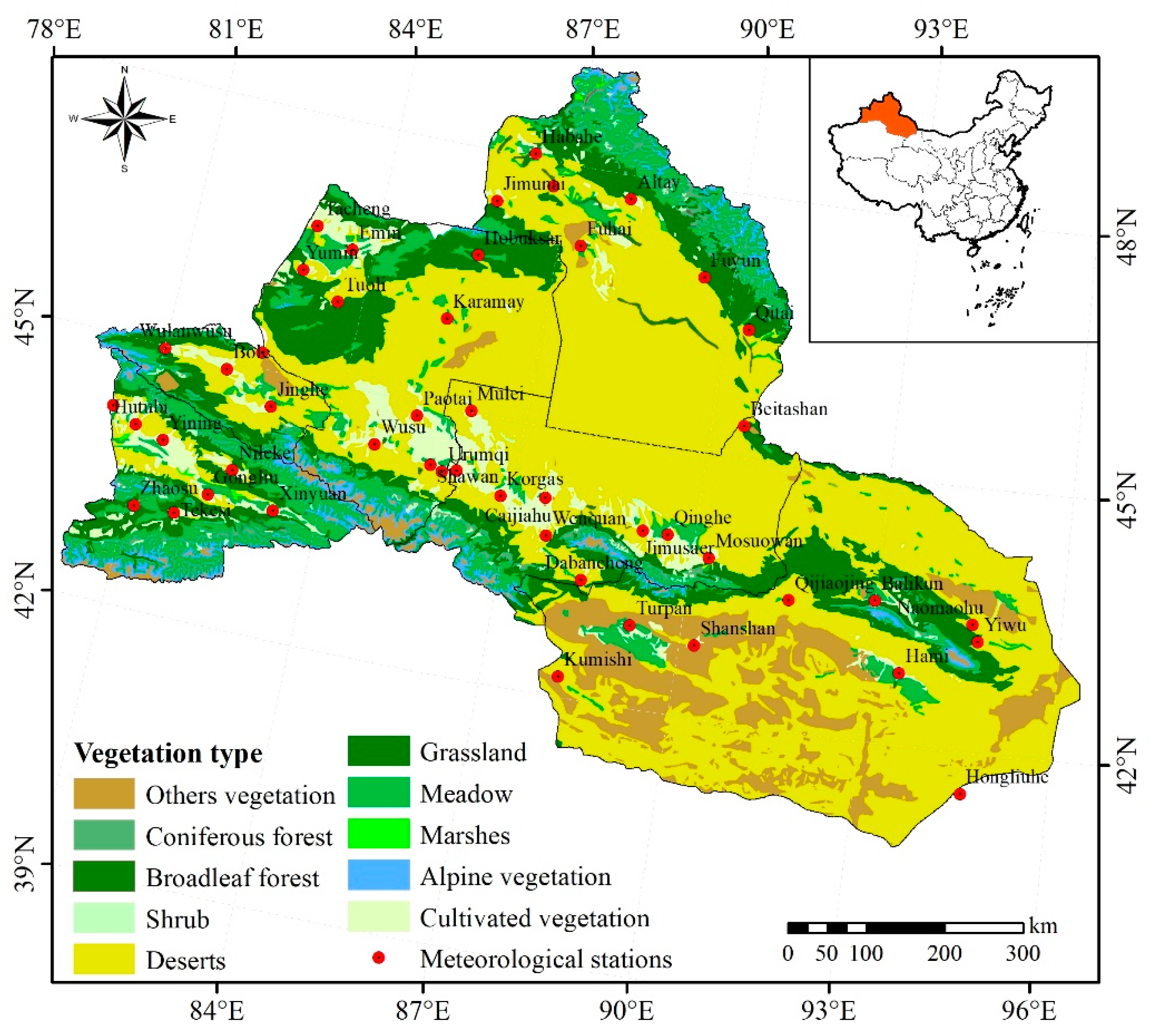
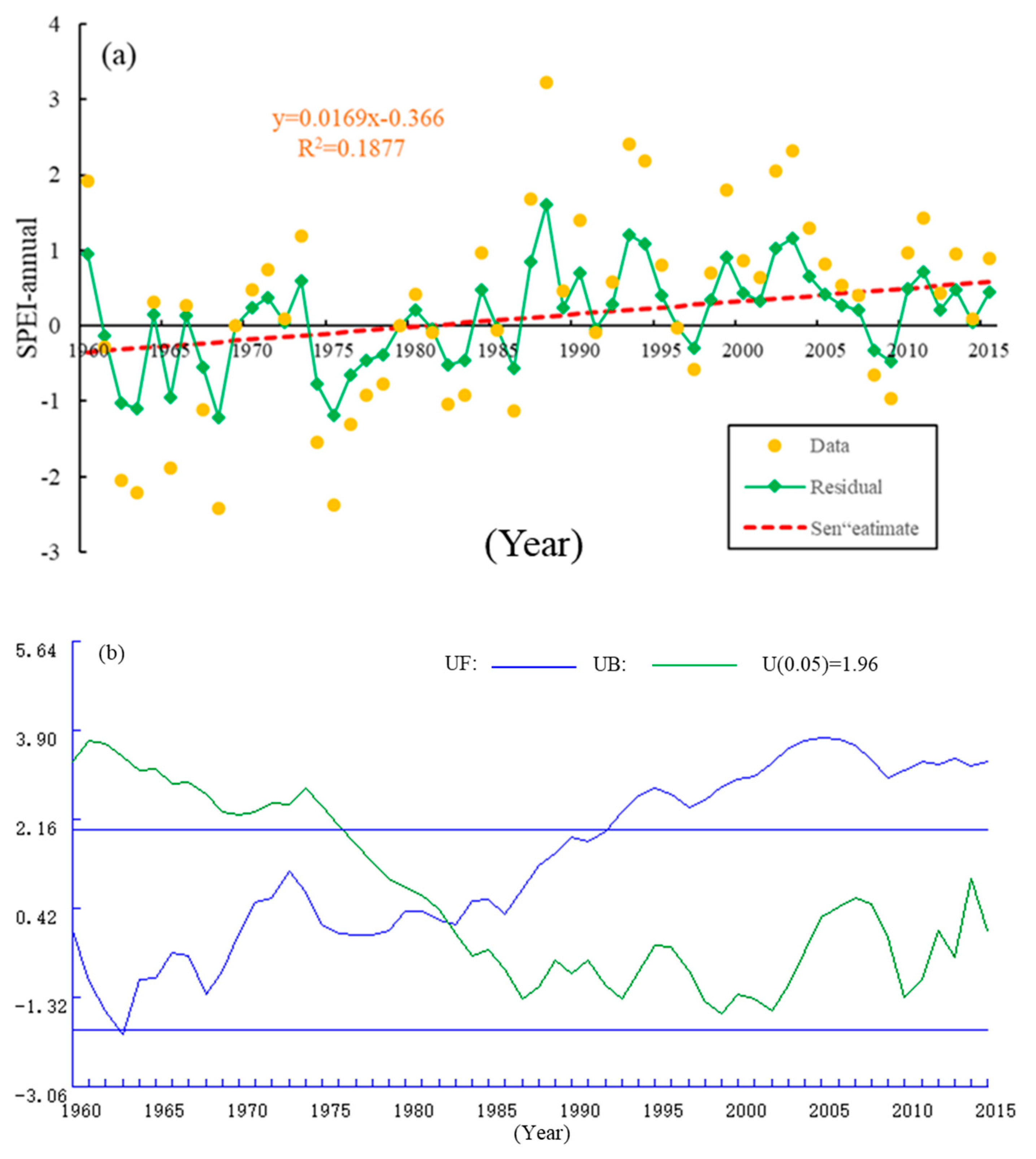
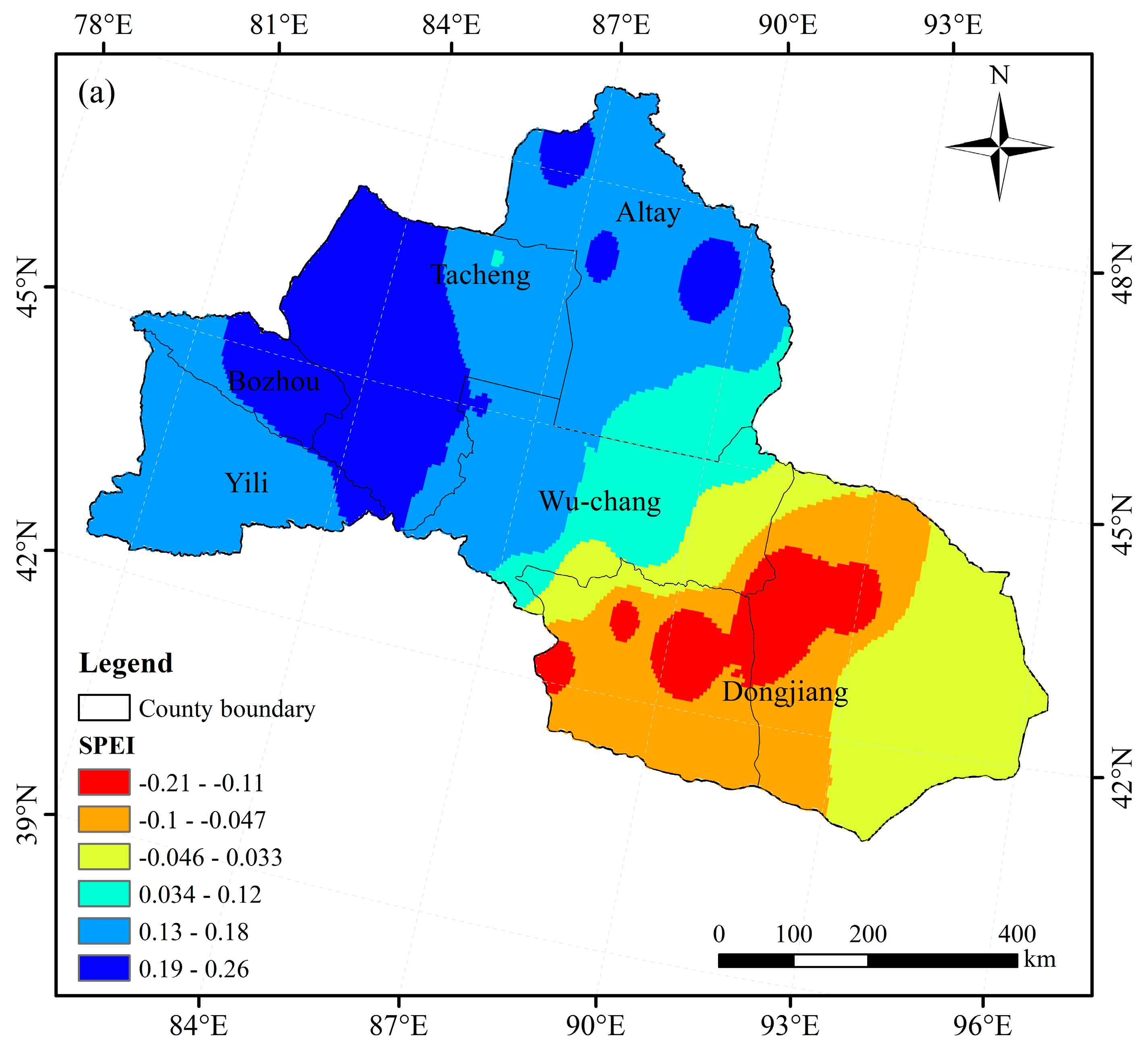
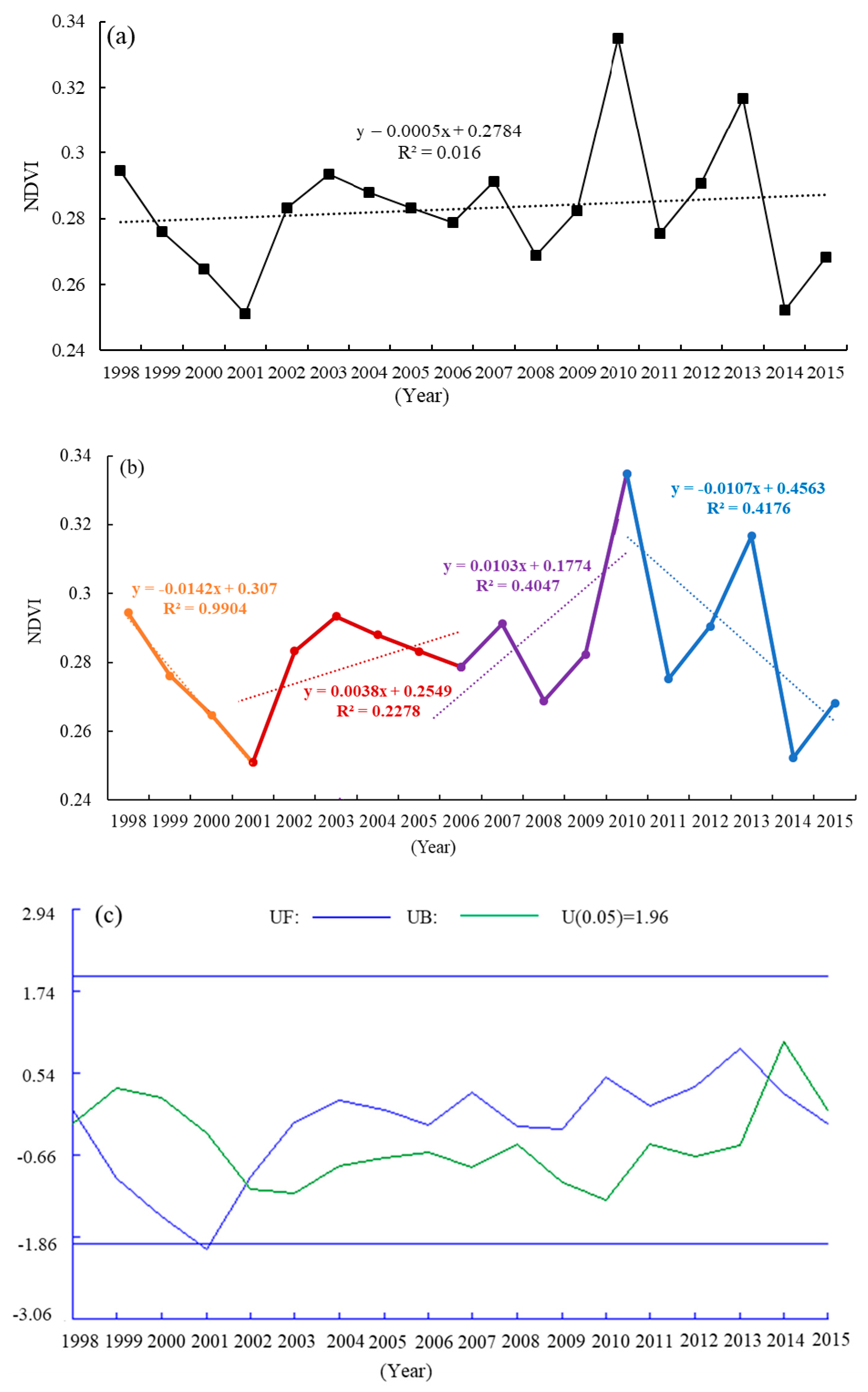
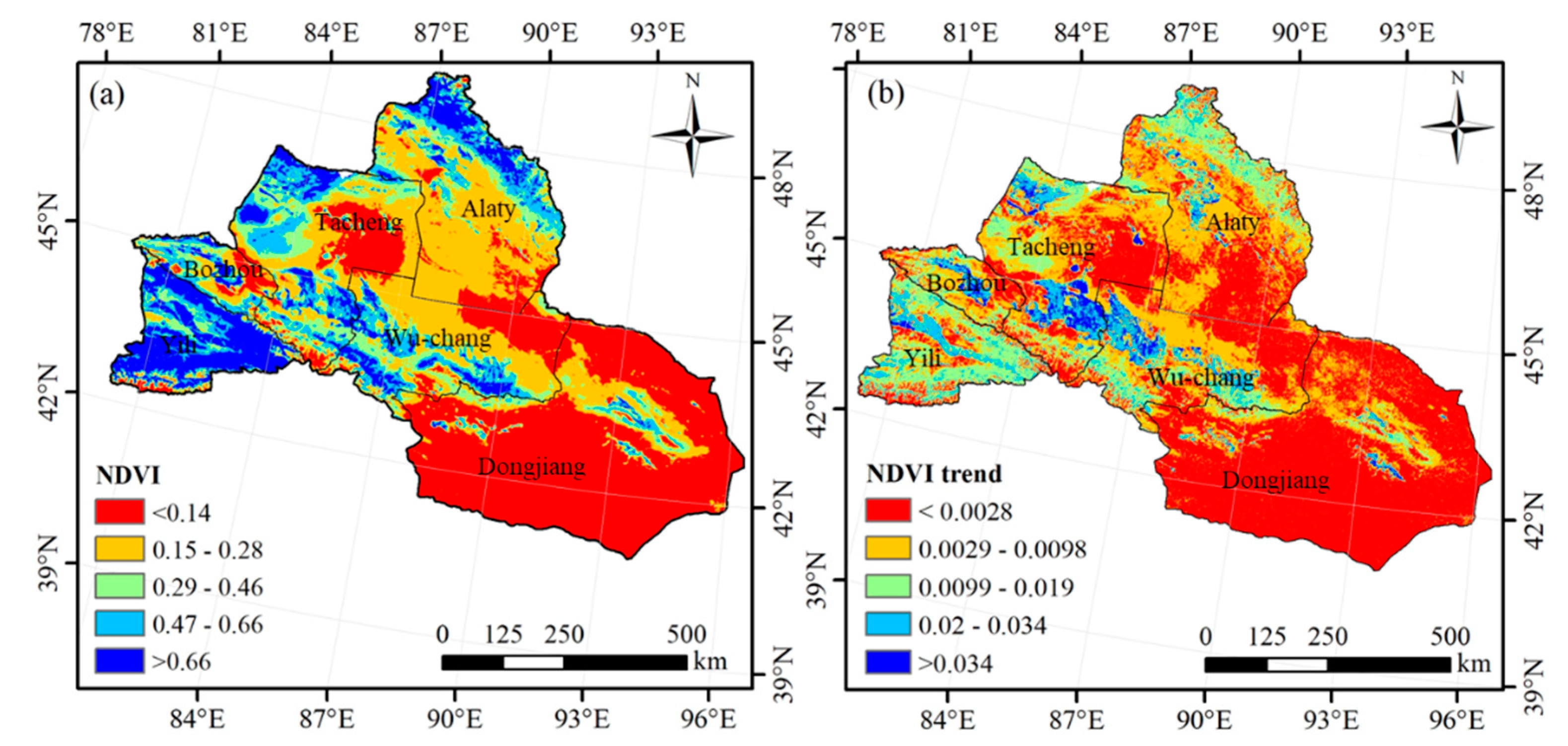

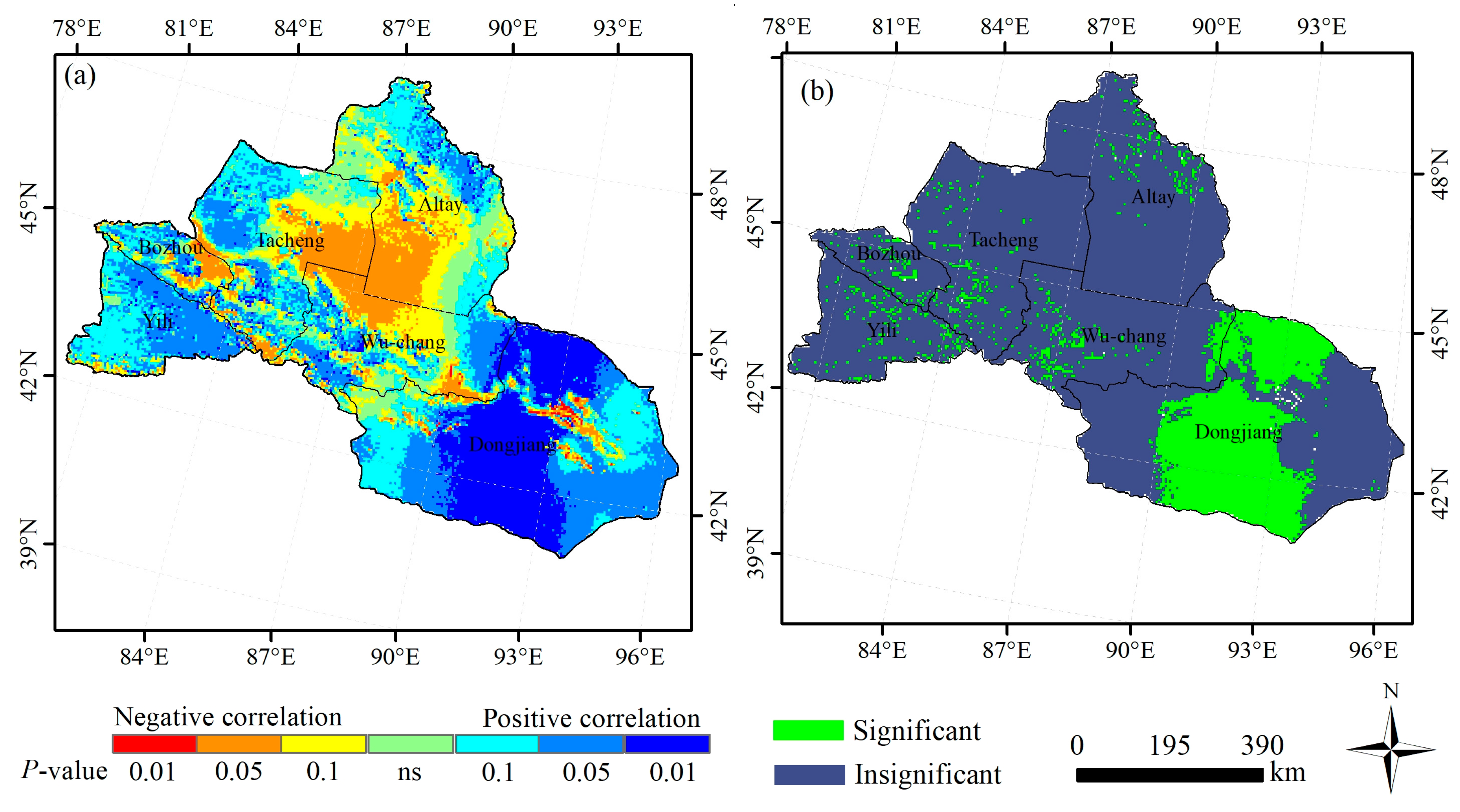
| Level | Type | Drought Severity |
|---|---|---|
| 1 | SPEI ≥ 2 | Extremely wet |
| 2 | 1.5 < SPEI ≤ 2 | Severely wet |
| 3 | 1 < SPEI ≤ 1.5 | Moderately wet |
| 4 | −1 < SPEI ≤ 1 | Near normal |
| 5 | −1.0 < SPEI ≤ −0.5 | Mild drought |
| 6 | −1.5 < SPEI ≤ −1.0 | Moderate drought |
| 7 | −2.0 < SPEI ≤ −1.5 | Severe drought |
| 8 | SPEI ≤ −2.0 | Extreme drought |
| 1998–2015 | Precipitation | Temperature | NDVI |
|---|---|---|---|
| Precipitation | 1 | 0.469 * | 0.541 * |
| Temperature | 1 | 0.127 | |
| NDVI | 1 |
| Vegetation Index | Period | Spei (Zero Year Lag) | Spei (One Year Lag) | Spei (Three-Year Lag) | Spei (Five-Year Lag) |
|---|---|---|---|---|---|
| NDVI-annual | 1998–2015 | 0.4718 | −0.209 | 0.106 | 0.146 * |
© 2020 by the authors. Licensee MDPI, Basel, Switzerland. This article is an open access article distributed under the terms and conditions of the Creative Commons Attribution (CC BY) license (http://creativecommons.org/licenses/by/4.0/).
Share and Cite
Luo, N.; Mao, D.; Wen, B.; Liu, X. Climate Change Affected Vegetation Dynamics in the Northern Xinjiang of China: Evaluation by SPEI and NDVI. Land 2020, 9, 90. https://doi.org/10.3390/land9030090
Luo N, Mao D, Wen B, Liu X. Climate Change Affected Vegetation Dynamics in the Northern Xinjiang of China: Evaluation by SPEI and NDVI. Land. 2020; 9(3):90. https://doi.org/10.3390/land9030090
Chicago/Turabian StyleLuo, Nana, Dehua Mao, Bolong Wen, and Xingtu Liu. 2020. "Climate Change Affected Vegetation Dynamics in the Northern Xinjiang of China: Evaluation by SPEI and NDVI" Land 9, no. 3: 90. https://doi.org/10.3390/land9030090
APA StyleLuo, N., Mao, D., Wen, B., & Liu, X. (2020). Climate Change Affected Vegetation Dynamics in the Northern Xinjiang of China: Evaluation by SPEI and NDVI. Land, 9(3), 90. https://doi.org/10.3390/land9030090






